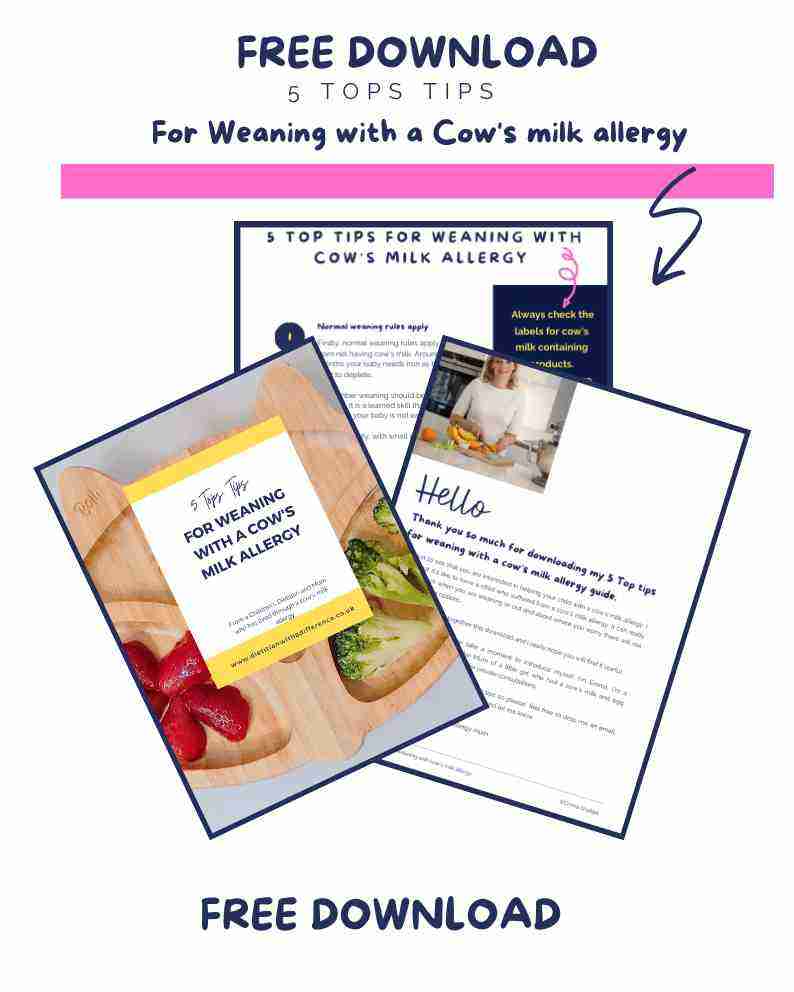In this blog we dive into understanding Cow’s Milk Protein Allergy (CMPA) symptoms. As a mum who has lived this path, I am aware of the difficulties faced by families dealing with CMPA. The emotional weight, the sleepless nights, the diligent label reading – it all contributes to a journey that can be isolating and overwhelming.
This personal journey became the driving force behind my pursuit of becoming a paediatric dietitian, fuelled by the desire to support and guide parents through the complexities of CMPA.
Understanding the struggles firsthand, I became passionate about contributing to the well-being of children affected by CMPA and providing parents with the knowledge and support they need. This is not just a profession for me; it’s a mission rooted in empathy and firsthand understanding.
We will delve into CMPA symptoms– from recognising early signs to understanding diagnostic methods, navigating emotional challenges, and offering practical tips.
Together, let’s unravel the complexities of CMPA symptoms, drawing from both my professional insights as a dietitian and personal experiences as a mum who lived through a milk allergy with my little girl.
What is CMPA
Cow’s Milk Protein Allergy (CMPA) is an immune system response to proteins found in cow’s milk, primarily casein and whey. Unlike lactose intolerance, which involves the inability to digest lactose sugar, CMPA is an allergic reaction to the proteins present in milk.
The immune system of an infant with CMPA recognises these proteins as harmful invaders, triggering an array of symptoms as a defensive response.
Types of Cow’s milk allergy
There are two types of CMPA:
IgE mediated food allergy which is caused by immunoglobulin E Antibody. The symptoms are quick and usually within minutes to two hours after consuming cow’s milk.
Non IgE mediated food allergy is caused by a different part of the immune system reacting in a different way. It is delayed and occurs from 2 hours to up to 72 hours after consuming cow’s milk.
Causes of CMPA
The causes of CMPA are multifaceted, often involving a combination of genetic and environmental factors. Infants may develop CMPA when introduced to cow’s milk-based formula or dairy-containing solids.
CMPA breastfeeding
Additionally, it can affect exclusively breastfed infants if the mother’s diet includes cow’s milk, as the proteins can be transferred through breast milk.
Prevalence and Common Age of Onset in Infants
CMPA stands as one is the most common food allergy during infancy. The estimate prevalence of CMPA ranges from 0.5% to 3% in industrialized countries, and the lowest values are observed in breastfed infants. Its incidence ranges from 2% to 7.5% in the first year of life (1). It is essential to recognize that most children tend to outgrow it as their immune systems mature.
The age of onset for CMPA is often tied to the introduction of cow’s milk into the infant’s diet. Whether through formula or solid foods, the initial exposure to these proteins can lead to the development of allergic responses. Recognizing the signs early on and seeking professional guidance is paramount for effective management.
CMPA and Lactose Intolerance – What is the difference
CMPA and lactose intolerance share symptoms related to gastrointestinal distress, but their underlying mechanisms differ. Lactose intolerance results from insufficient levels of lactase, the enzyme responsible for breaking down lactose sugar. In contrast, CMPA involves an immune response to milk proteins.
Consulting with health care professionals becomes pivotal in distinguishing between these conditions and establishing an effective care plan tailored to the specific needs of the infant.
What are the symptoms of cows milk protein allergy in babies
Gastrointestinal Symptoms
Diarrhoea
One of the hallmark signs of Cow’s Milk Protein Allergy (CMPA) in infants is diarrhoea or I what I termed in my little girl cmpa poo or milk allergy poop. The immune response triggered by the intake of milk proteins can lead to irritation and inflammation in the gastrointestinal tract, resulting in loose and watery stools. Monitoring changes in your baby’s bowel habits is crucial for early recognition and intervention.
Vomiting
CMPA can also manifest through episodes of vomiting. This can occur shortly after consuming milk-containing formula, breast milk with traces of cow’s milk proteins, or when introducing dairy-based solid foods. Persistent vomiting, especially in combination with other symptoms, should prompt a discussion with a healthcare professional.
I still remember the vomiting and the constant need for more muslins and never putting my little girl down.
Reflux
Gastroesophageal reflux, commonly known as reflux, is another gastrointestinal symptom associated with CMPA. Infants with CMPA may experience the regurgitation of stomach contents into the oesophagus, leading to discomfort and irritability.
However, babies can also experience reflux too and it is not related to a CMPA so speak to your health professional to identify possible causes of reflux. This was a symptom we experienced with my little girl.
Skin-Related Symptoms – CMPA Rash
Eczema
CMPA can presents itself through skin-related symptoms, with eczema being a manifestation. Eczema in infants with CMPA tends to be persistent and may not respond to conventional treatments. Itchy rashes, redness, and inflammation on various parts of the body, particularly the face and extremities, are common indicators. However, just to confuse things eczema can be caused by lots of factors too and nothing to do with a milk allergy.
Hives
Hives, or urticaria, are raised, red welts on the skin that may be accompanied by itching. This skin reaction can occur shortly after exposure to cow’s milk proteins and is part of the immune system’s response to the allergen. Hives may appear suddenly and vary in size, providing a visual cue for parents to consider the possibility of CMPA.
Respiratory Symptoms
Coughing
Respiratory symptoms can also be associated with CMPA, and coughing is one such manifestation. The immune response triggered by milk proteins can affect the respiratory system, leading to persistent coughing. Understanding the potential connection between respiratory symptoms and CMPA is crucial for accurate diagnosis and comprehensive care.
Wheezing
Wheezing, characterised by a high-pitched whistling sound during breathing, is another respiratory symptom that may indicate CMPA. This can be particularly concerning and requires prompt attention from healthcare professionals.
Recognizing these varied symptoms is key to addressing CMPA effectively. If you observe any of these signs in your infant, seeking timely medical advice is crucial for proper diagnosis and the initiation of an appropriate care plan.
Discomfort
This was the main feature of my little girls’ symptoms and where I knew something was wrong. She was so unhappy, crying all the time, arching her back and eventually refusing to feed completely around 3 months old.
Diagnosis and Testing
Skin Prick Tests
Skin prick tests are a common diagnostic method used to identify allergic sensitivities, including CMPA. During this test, a small amount of diluted cow’s milk protein is applied to the skin, and the skin is gently pricked. The healthcare provider then observes the skin’s reaction, looking for signs of an allergic response, such as redness or swelling.
Blood Tests
Blood tests, specifically those measuring immunoglobulin E (IgE) antibodies, can provide valuable insights into the presence of an allergic response. Elevated levels of IgE antibodies specific to cow’s milk proteins indicate sensitization and potential allergic reactions. Blood tests are particularly useful in diagnosing immediate-type allergic responses. But they also need to interpret by a health professional with a detailed and full consultation to gain a full understanding of the child.
But skin prick or blood tests are not suitable to diagnosis a delayed non IgE cow’s milk allergy. This should be confirmed via an elimination diet instead.
Elimination Diets
In certain cases, healthcare professionals may recommend an elimination diet as a diagnostic tool. This involves removing cow’s milk and dairy products from the infant’s or breastfeeding mother’s diet for a specified period. The subsequent observation of symptom improvement during this elimination phase can contribute to the diagnosis of CMPA. However, elimination diets should be supervised by healthcare professionals to ensure proper nutrition and avoid unintended consequences.
Challenges in Diagnosing CMPA
Diagnosing CMPA can present challenges due to the diverse and sometimes subtle nature of its symptoms. Gastrointestinal, skin-related, and respiratory symptoms may overlap with other conditions, complicating the diagnostic process. Additionally, delayed-type allergic reactions can make it challenging to link symptoms directly to cow’s milk consumption.
The importance of professional guidance in navigating these challenges cannot be overstated. Healthcare professionals and paediatric dietitian can bring their expertise to the table, utilizing a combination of clinical history, physical examinations, and diagnostic tests to arrive at an accurate diagnosis. It is crucial for parents to communicate openly with their healthcare team and dietitian, providing detailed information about their baby’s symptoms, diet, and overall health.
Role of a Paediatric Dietitian in Managing CMPA
The expertise of a paediatric dietitian is instrumental in navigating the challenges posed by Cow’s Milk Protein Allergy (CMPA). These professionals play a pivotal role in assessing nutritional needs, crafting specialised diets, and guiding parents through the complexities of managing CMPA.
A paediatric dietitian collaborates with healthcare teams to ensure infants receive the necessary nutrients for optimal growth and development, even in the absence of cow’s milk.

Crafting a Balanced and Nutritious CMPA-Friendly Diet for Infants
Creating a balanced and nutritious diet for infants with CMPA requires careful consideration of alternative sources of essential nutrients.
A paediatric dietitian can provide tailored guidance on suitable formula options, fortified foods, and nutrient-rich alternatives to compensate for the removal of cow’s milk from the diet. Crafting a diet that meets the specific needs of CMPA infants is crucial for their overall health and well-being.
Tips for Parents in Navigating Food Choices for CMPA Babies
Parents of infants with CMPA often face the challenge of making informed food choices that align with their baby’s dietary restrictions.
A paediatric dietitian can offer practical tips and guidance on reading food labels, identifying hidden sources of cow’s milk, and selecting appropriate weaning foods. Empowering parents with the knowledge to make informed choices ensures that their CMPA babies receive the nutrition they need while avoiding potential allergens.
Emotional Support for Parents
As a parent of a child with CMPA I know how emotionally taxing it is for parents. Coping with stress and frustration is a significant aspect of managing the daily uncertainties that arise. It’s essential to acknowledge that navigating CMPA is a journey with ups and downs, and giving yourself permission to experience and express these emotions is a crucial step in coping.
Remember, you are not alone on this journey I have been there. Together, we can create an environment where every child affected by CMPA can thrive, supported by informed and resilient caregivers.
Here’s to the health and happiness of your little ones and the strength that lies within each parent navigating the challenges of CMPA. I know how hard it is, but I am here to support you. I offer virtual 1.1 consultations to help with CMPA or download my free weaning guide for CMPA.

Written by Emma Shafqat BSc RD, Dietitian and Nutritionist.
“Dietitian with a Difference” holds no liability for any adverse reactions that may arise from the advice in the blog. The content provided is for informational purposes only and does not replace professional medical advice.


